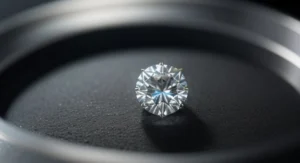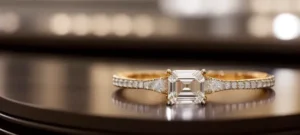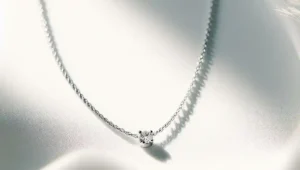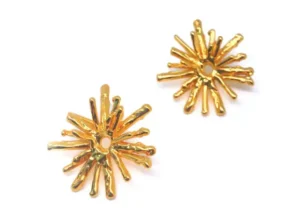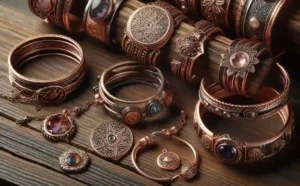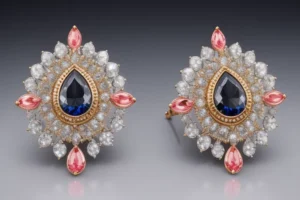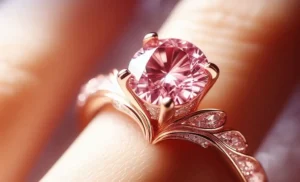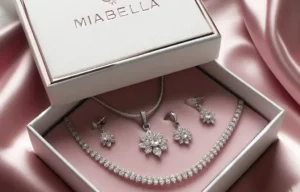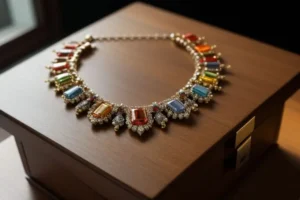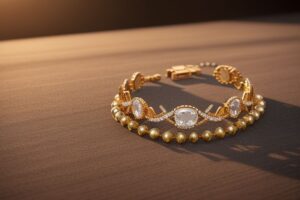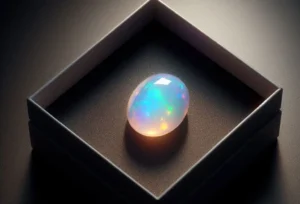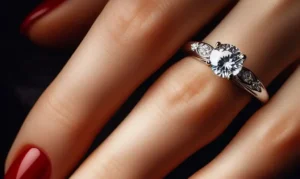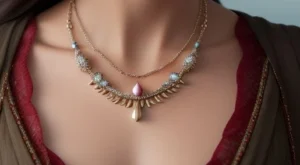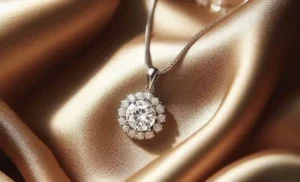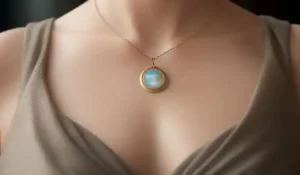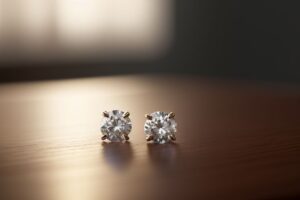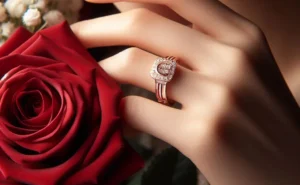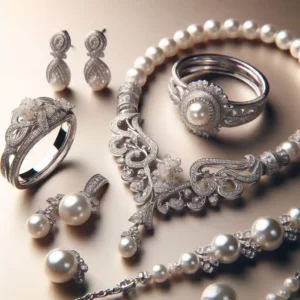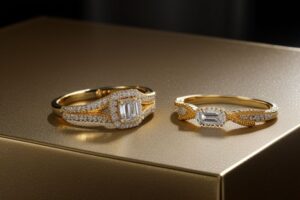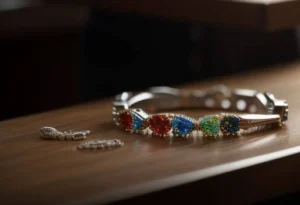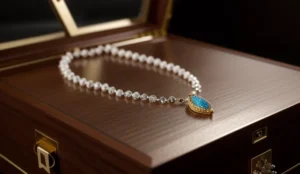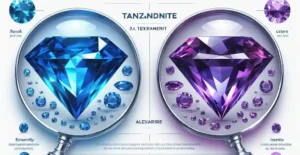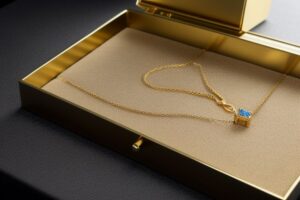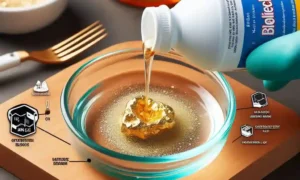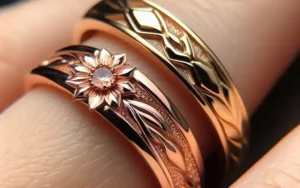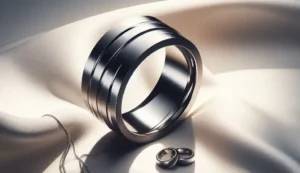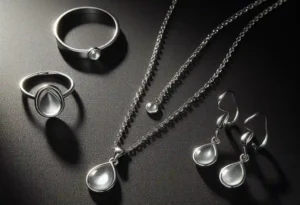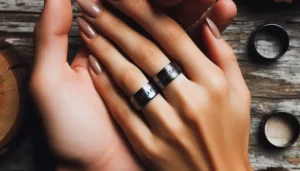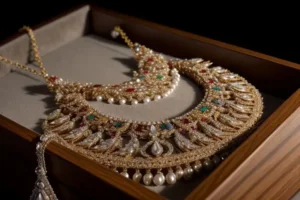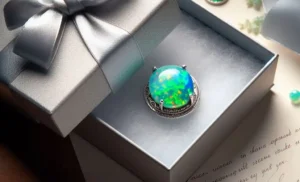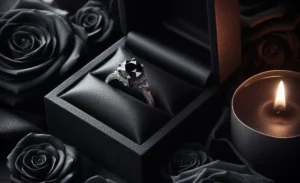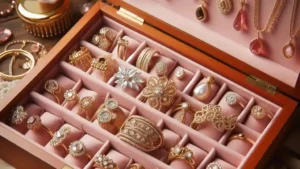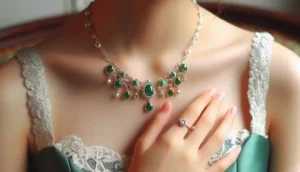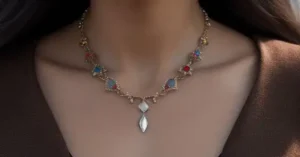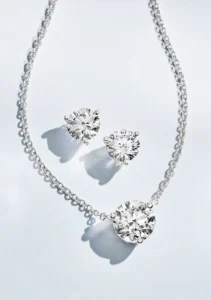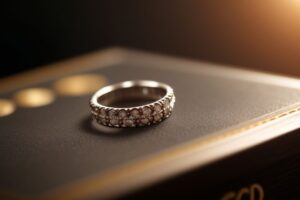How to Tell if Black Diamond is Real? – In the glittering world of gemstones, black diamonds stand out for their mesmerizing beauty and unique allure. But as their popularity soars, so does the market for imitations.
Distinguishing a genuine black diamond from a clever counterfeit can be daunting for the untrained eye.
In this comprehensive guide, we unravel the mystery behind these enigmatic stones and equip you with the knowledge to verify the authenticity of your black diamond.
How to Tell if Black Diamond is Real?
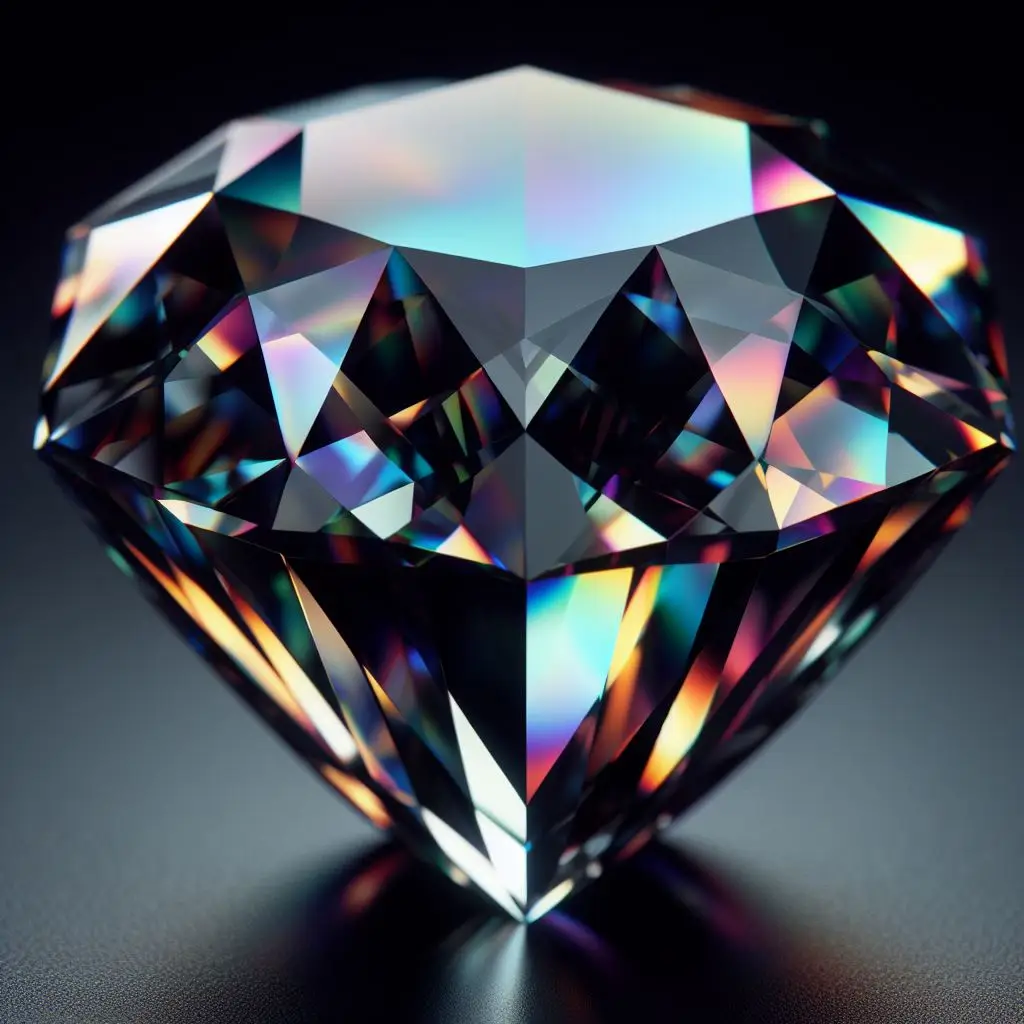
– **Visual Inspection:** Check for uniform color saturation and natural imperfections. Genuine black diamonds often have a deep black hue and may include minor surface blemishes or internal inclusions, which are indicative of their natural origin.
– **Weight Test:** Compare the heft of the black diamond to another diamond of similar size and shape. Real black diamonds possess a high density, making them feel noticeably heavier.
– **Water Test:** Drop the diamond into a glass of water. A genuine black diamond, due to its density, will sink quickly to the bottom.
– **Magnifying Examination:** Use a magnifying glass or jeweler’s loupe to look for natural inclusions. These may appear as small white or gray flecks or threads within the stone, signifying authenticity.
– **Heat Test:** Briefly expose the diamond to intense heat then cool it rapidly in water. A real diamond will resist thermal shock without damage, whereas counterfeit materials may crack or shatter.
– **Seek Professional Appraisal:** When in doubt, a certified gemologist can provide a definitive analysis of the diamond’s authenticity using advanced diagnostic tools.
– **Certification:** Ensure the diamond comes with certification from a reputable gemological organization, confirming its authenticity and characteristics.
Understanding the Basics of Black Diamonds

Black diamonds, known in the gemological world as carbonado, diverge significantly from their clearer diamond counterparts not just in color but in composition and formation.
These intriguing stones derive their dark colouration from the presence of graphite and, in some instances, amorphous carbon, which is integrated within the diamond while forming deep within the Earth.
Unlike traditional diamonds that form in the Earth’s mantle, black diamonds are believed to have originated in interstellar space, arriving on Earth via asteroid impacts.
This cosmic theory explains their unique polycrystalline structure, which refracts light differently than other diamonds, resulting in their opaque, deep black appearance that doesn’t sparkle in the traditional sense.
The Mohs scale, which measures mineral hardness, rates diamonds at the pinnacle of 10; black diamonds share this exceptional hardness, making them incredibly durable.
It’s this combination of unique origin, composition, and physical properties that set black diamonds apart in the gemstone universe, offering a fascinating subject for both jewellers and gem enthusiasts alike. Their rarity and distinctive beauty make them a sought-after choice for jewelry, symbolizing strength, passion, and transcendence.
The Visual Inspection: What to Look For
Embarking on a visual inspection involves scrutinizing the stone under ample lighting to discern key characteristics indicative of its authenticity. As you assess, pay special attention to the color saturation and consistency across the gemstone.
Authentic black diamonds typically exhibit a homogeneous deep black hue, although slight hue variances are plausible due to natural formation processes. It’s imperative to also be on the lookout for any surface imperfections or blemishes, as these are hallmarks of a natural diamond’s journey from creation to discovery.
Such imperfections, including scratches or pits, can serve as authenticating markers, as synthetics or treated stones often present a flawless exterior that can be suspicious. However, it’s essential to differentiate these natural imperfections from potential damage or poor craftsmanship, which could detract from the stone’s value and appeal.
Through meticulous observation of these aspects, the visual inspection phase can significantly inform your assessment of the diamond’s authenticity, guiding you towards a deeper understanding of its origin and value.
This stage lays the groundwork for more definitive testing and, potentially, professional evaluation to ascertain the true nature of your black diamond.
The Weight Test: Density Matters
The weight test is a simple yet effective way to gauge the authenticity of a black diamond by exploiting a key physical property: density. Genuine black diamonds have a notably higher density than most materials used to create counterfeit stones.
This test requires having another diamond of known authenticity, ideally of a similar size and shape for an accurate comparison. When held in the hand, the black diamond in question should exhibit a discernible heftiness if it is real.
Although this method alone doesn’t offer a definitive verdict on the stone’s authenticity, it serves as an informative preliminary assessment. The difference in weight, while subtle, is a direct reflection of the black diamond’s dense composition, stemming from its unique formation process.
This comparison can be particularly telling, as counterfeit versions often use materials that, while visually similar, cannot replicate the natural density of a black diamond. Engaging in this test, one should remember that it’s a piece of the puzzle in determining the stone’s authenticity, leading to further investigation and potentially prompting a professional evaluation for those stones that pass this initial phase.
The Water Test: Simple but Revealing
For a straightforward approach to assess the authenticity of a black diamond, the water test can be quite telling. This experiment leverages the high density characteristic of genuine diamonds. Start by filling a glass with water. Carefully drop the stone into the center of the glass.
Observing its response, a real black diamond, due to its substantial density, will immediately descend to the bottom of the glass. A slower descent, or worse, buoyancy, could indicate that the stone in question does not possess the hallmark density of a genuine diamond.
It’s critical to note, however, that this method is not foolproof. There are materials that can mimic the density of a diamond closely enough to pass this test. Therefore, while the water test can be a useful preliminary assessment, it should not be the sole basis for determining a stone’s authenticity.
Engaging in this test provides an initial gauge of the stone’s density, prompting further examination and possibly leading to professional evaluation for a definitive verdict on its genuineness.
Using a Magnifying Glass: Spotting Surface Inclusions
Equipping yourself with a magnifying glass or a jeweler’s loupe transforms your visual inspection into a detailed investigation of the diamond’s internal world. When observing a black diamond closely, one seeks the telltale signs of natural formation, which manifest as inclusions.
These are essentially the fingerprints of nature, unique to each stone. Within the dark expanse of a genuine black diamond, inclusions might appear as minute white or grey flecks, threads, or clouds. Their presence is a strong indicator of authenticity, as they represent internal characteristics formed during the diamond’s creation deep within the Earth.
In contrast, the synthetic or treated stones often used to imitate black diamonds may lack these natural inclusions or present them in patterns that do not align with those seen in natural diamonds. Some counterfeit stones might be too perfect, lacking any inclusions at all, which is atypical for genuine black diamonds.
This absence or unnatural appearance of inclusions under magnification can signal a need for skepticism about the stone’s origin and authenticity.
When using magnification to inspect a black diamond, it’s crucial to move beyond a superficial glance, delving into the depths of the stone’s interior. This careful scrutiny can unveil the hidden characteristics that distinguish a true black diamond from its imitations, offering insights that are invaluable in the quest to authenticate your precious gem.
The Heat Test: Assessing Durability
The Heat Test is a more advanced technique that capitalizes on a diamond’s exceptional thermal durability. By subjecting the black diamond to a brief exposure to intense heat—around 30 seconds—and subsequently plunging it into cold water, one can assess its genuine nature.
A real diamond, known for its robustness against extreme temperature changes, will withstand this thermal shock without showing any signs of damage. This remarkable resilience is a hallmark of true diamonds, distinguishing them from most counterfeit materials that are likely to crack or become damaged under such stress.
It is critical, however, to approach this test with caution. The potential for damage to the stone, especially if it’s not a genuine diamond, is a genuine risk. Therefore, this test is recommended to be either conducted under the supervision of a professional or considered only after other, less risky methods have been employed.
The Heat Test leverages the intrinsic properties of diamonds to further authenticate their realness but should be executed with full awareness of the potential consequences to ensure the preservation of the gemstone’s integrity.
Professional Appraisal: The Ultimate Verification
When the DIY methods leave room for doubt, seeking a professional appraisal emerges as the definitive step towards verifying your black diamond’s authenticity. Certified gemologists bring to the table not only their extensive knowledge but also access to sophisticated diagnostic equipment.
These tools include spectroscopes, which analyze the light spectrum to identify the stone’s composition, and electron microscopes, offering a magnified view of the gemstone’s structure that’s invisible to the naked eye.
Such detailed examinations can uncover the minutest details about the diamond, such as its crystal structure, inclusions, and even hints about its geological formation, which are critical in distinguishing genuine black diamonds from imitations.
A professional appraisal goes beyond a mere authenticity check. It also provides an in-depth analysis of the diamond’s quality, including its cut, color, clarity, and carat weight, which are indispensable in determining its market value.
This rigorous process ensures that every facet of the stone is meticulously evaluated, offering you a comprehensive understanding of your gemstone’s true worth and heritage.
Opting for a certified gemologist’s expertise is not just about attesting to the stone’s authenticity; it’s an investment in gaining a precise insight into its provenance and quality, anchoring your trust in the black diamond’s genuine allure and value.
Understanding the Importance of Certification
Certification from a recognized authority is crucial when it comes to the authenticity and quality of black diamonds. Notable organizations such as the Gemological Institute of America (GIA) or the International Gemological Institute (IGI) conduct thorough examinations and issue certificates that detail a diamond’s characteristics, including its dimensions, color, clarity, cut, and other critical attributes.
This documentation serves as an irrefutable proof of the diamond’s properties and confirms its genuine nature. It’s an essential aspect of diamond purchasing, providing a buyer not only with security but also with a clear insight into the gemstone’s value.
The certification process involves sophisticated testing and analysis, offering an objective assessment that surpasses the scope of basic home testing methods.
Possessing a certificate for your black diamond is akin to holding a biography of its journey from the depths of the earth to your collection, encapsulating its story and substantiating its worth.
Always prioritize acquiring a black diamond with the appropriate certification to ensure you’re investing in a piece that’s not only captivating but also authenticated by the standards of the gemological community.


